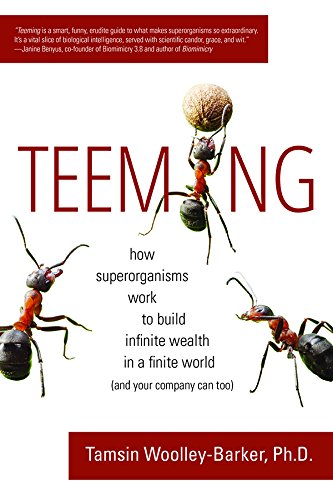biomimicry
Synapse by Biomimicry 3.8
Mon, 2017/12/04 - 17:32 — nhoellerSynapse by Biomimicry 3.8 is an environment for our staff to share their expertise and thought leadership in biomimicry with the world.
It's our way of inviting you to join us in our awe of the natural world and discover the inspirational ways that innovators from around the world are using biomimicry to solve tough challenges, including sharing our own tips and techniques for bringing nature's genius to the design table.
Get free infographics, presentation slides, toolkits, biomimicry basics tools, and tips from the world’s leading biomimicry experts, including resources curated by Janine Benyus and Dr. Dayna Baumeister.
Biomimicry UK "Behind the Science: YouTube Channel
Mon, 2017/12/04 - 17:26 — nhoellerStarting in November, we will be interviewing innovators, academics and thought leaders behind the research and development of some of the leading innovations in the field.
First up is Prof. Marc Desmuilliez from Heriot-Watt University in Scotland, whose is expertise is in the field of electronics, systems and manufacturing. His work has led to over 400 publications (I know!) and two spinout companies from the university labs.
Teeming: How Superorganisms Work Together to Build Infinite Wealth on a Finite Planet
Thu, 2017/07/20 - 19:19 — nhoeller2017/08/21 uploaded PDF of TOC and Prologue (see below text)
Written by Tamsin Woolley-Barker. Also available on Amazon.ca.
An entertaining and accessible read with profound implications for the future, Teeming takes us on a journey through nature's most ancient and successful R&D labs, and gives practical prescriptions for redesigning organizations to flourish far into the future. Evolutionary biologist Woolley-Barker weaves poetic vision and deep scientific expertise to illustrate how flat, agile, and adaptive societies like ants, termites, and underground fungal networks self-organize for resilience and value.
Biomimicry Basics: How To Innovate Using Nature's Strategies
Thu, 2017/03/30 - 19:03 — nhoellerIf you take this course, you will be able to:
- Describe what biomimicry is and how it relates to other forms of bio-inspired design
- Use the Biomimicry for Design methodology (the Biomimicry Design Spiral) for technical and non- technical design challenges
- Articulate why biomimicry is valuable for your organization
- Integrate biomimicry into your design process or innovation pathway
Seedkit: design concepts learned from Pacific Northwest forests
Thu, 2017/03/30 - 18:52 — nhoellerHow does the Northwest Forest evaporate such large volumes of rainwater? And how can our buildings and infrastructure mimic those strategies to reduce polluted runoff?
An orientation to biomimicry for K-12 Teachers
Thu, 2017/03/30 - 18:43 — nhoellerThis publication was created to help K-12 educators establish a general foundation in biomimicry and provide ideas for introducing this new way of thinking and problem solving to their students. It begins with a general introduction to the “what” and “why” of biomimicry, along with some ideas for how to fit biomimicry into your education program. The Core Concepts section that follows the introduction provides added depth in key areas and offers additional suggestions and resources for sharing these concepts with students of varying ages.
Biomimicry Taxonomy
Thu, 2017/03/30 - 18:41 — nhoellerThe Taxonomy is a classification system we developed to organize biological strategies by the functions they serve, such as: How does nature store water? Save energy? Protect from impact? We built it to organize the data in AskNature and make it easier to search. It’s our master reference tool designed for innovators like you.
One way to "ask nature" for design guidance is to break your challenges down into their fundamental functions—the specific outcomes your design needs to achieve. Identifying the function, "distribute liquids," for example, and then searching for those keywords on AskNature, will provide multiple potential solutions on how nature performs that function, which you can then apply to your own challenge.
Think Biomimicry - Shift From Idea to Implementation
Wed, 2016/11/02 - 10:26 — nhoellerBy Biomimicry Chicago's Rachel Hahs ... [who] explores how we can shift from just being excited about the ideas behind biomimicry, to implementing biomimicry in practice in whatever fields we work.
Her most recent post, (Re)connecting with Nature, takes a look at how the first step to practicing biomimicry requires gaining the skills to slow down long enough to keenly observe the world around us with a curious and open mind - only then will we be able to truly learn from nature. Her previous posts touch on explaining what biomimicry is, how to use it, and how we think about it in the built environment.
The website also includes a comprehensive list of online biomimicry resources (please let us know if you have resources to add!), and periodically updated photography collections. Enjoy!
Biomimicry Basics: How To Innovate Using Nature's Strategies
Thu, 2016/08/18 - 13:47 — nhoellerIf you take this course, you will be able to:
- Describe what biomimicry is and how it relates to other forms of bio-inspired design
- Use the Biomimicry for Design methodology (the Biomimicry Design Spiral) for technical and non- technical design challenges
- Articulate why biomimicry is valuable for your organization
- Integrate biomimicry into your design process or innovation pathway
Instructor: Denise DeLuca, PE
Le vivant comme modèle, la voie du biomimétisme
Fri, 2016/01/01 - 20:40 — nhoellerOriginally posted at https://www.linkedin.com/pulse/my-biomimicry-book-available-gauthier-chapelle. English translation courtesy of Google and Microsoft.
En cette veille de Noël, je voulais enfin vous annoncer la sortie de mon livre "Le vivant comme modèle, la voie du biomimétisme" chez Albin-Michel, préfacé par Nicolas Hulot et Jean-Marie Pelt (qui nous a quittés cette nuit, hommage à lui). On this Christmas Eve, I wanted to finally announce the release of my book Living as a model, the way of biomimicry published by Albin-Michel, foreword by Nicolas Hulot and Jean-Marie Pelt (who left us this night, in tribute to him). Gauthier Chapelle
